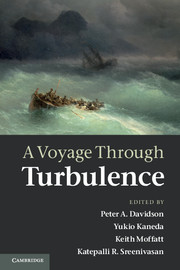Book contents
- Frontmatter
- Contents
- List of contributors
- Preface
- 1 Osborne Reynolds: a turbulent life
- 2 Prandtl and the Göttingen school
- 3 Theodore von Kármán
- 4 G.I. Taylor: the inspiration behind the Cambridge school
- 5 Lewis Fry Richardson
- 6 The Russian school
- 7 Stanley Corrsin
- 8 George Batchelor: the post-war renaissance of research in turbulence
- 9 A.A. Townsend
- 10 Robert H. Kraichnan
- 11 Satish Dhawan
- 12 Philip G. Saffman
- 13 Epilogue: a turbulence timeline
- References
12 - Philip G. Saffman
Published online by Cambridge University Press: 07 October 2011
- Frontmatter
- Contents
- List of contributors
- Preface
- 1 Osborne Reynolds: a turbulent life
- 2 Prandtl and the Göttingen school
- 3 Theodore von Kármán
- 4 G.I. Taylor: the inspiration behind the Cambridge school
- 5 Lewis Fry Richardson
- 6 The Russian school
- 7 Stanley Corrsin
- 8 George Batchelor: the post-war renaissance of research in turbulence
- 9 A.A. Townsend
- 10 Robert H. Kraichnan
- 11 Satish Dhawan
- 12 Philip G. Saffman
- 13 Epilogue: a turbulence timeline
- References
Summary
Introduction
Philip G. Saffman was a leading theoretical fluid dynamicist of the second half of the twentieth century. He worked in many different sub-fields of fluid dynamics and, while his impact in other areas perhaps exceeded that in turbulence research, which is the topic of this article, his contributions to the theory of turbulence were significant and remain relevant today. He was also an incisive and, some might conclude, a somewhat harsh critic of progress or what he perceived as the lack thereof, in solving ‘the turbulence problem’. This extended to his own work; he stated in a preface to lectures on homogeneous turbulence (Saffman, 1968) that
the ideas … are new and hopefully important, but are speculative and quite possibly in serious error.
In this article, we will try to survey Saffman's thinking and contribution to turbulence research from the mid 1950s, when he began to mature as a scholar, until the late 1970s when he moved away from the study of turbulence to concentrate on the related but separate area, of the dynamics of isolated and interacting vortices. Although, for the most part, the evolution of his ideas and their application to turbulence in this period developed both thematically and chronologically together, where there are departures we will tend to focus on the former.
- Type
- Chapter
- Information
- A Voyage Through Turbulence , pp. 393 - 425Publisher: Cambridge University PressPrint publication year: 2011
References
- 2
- Cited by



